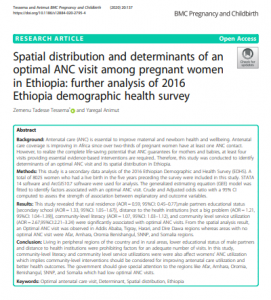
Background
Antenatal care (ANC) is essential to improve maternal and newborn health and wellbeing. Antenatal care coverage is improving in Africa since over two-thirds of pregnant women have at least one ANC contact. However, to realize the complete life-saving potential that ANC guarantees for mothers and babies, at least four visits providing essential evidence-based interventions are required. Therefore, this study was conducted to identify determinants of an optimal ANC visit and its spatial distribution in Ethiopia.
Methods
This study is a secondary data analysis of the 2016 Ethiopian Demographic and Health Survey (EDHS). A total of 8025 women who had a live birth in the five years preceding the survey were included in this study. STATA 14 software and ArcGIS10.7 software were used for analysis. The generalized estimating equation (GEE) model was fitted to identify factors associated with an optimal ANC visit. Crude and Adjusted odds ratio with a 95% CI computed to assess the strength of association between explanatory and outcome variables.
Results
This study revealed that rural residence (AOR = 0.59, 95%CI: 0.45–0.77),male partners educational status [secondary school (AOR = 1.33, 95%CI: 1.05–1.67)], distance to the health institutions [not a big problem (AOR = 1.21, 95%CI: 1.04–1.39)], community-level literacy (AOR = 1.07, 95%CI: 1.03–1.12), and community level service utilization (AOR = 2.67,95%CI:2.21–3.24) were significantly associated with optimal ANC visits. From the spatial analysis result, an Optimal ANC visit was observed in Addis Ababa, Tigray, Harari, and Dire Dawa regions whereas areas with no optimal ANC visit were Afar, Amhara, Oromia Benishangul, SNNP, and Somalia regions.
Conclusion
Living in peripheral regions of the country and in rural areas, lower educational status of male partners and distance to health institutions were prohibiting factors for an adequate number of visits. In this study, community-level literacy and community level service utilizations were were also affect womens’ ANC utilization which implies community-level interventions should be considered for improving antenatal care utilization and better health outcomes. The government should give special attention to the regions like Afar, Amhara, Oromia, Benishangul, SNNP, and Somalia which had low optimal ANC visits.